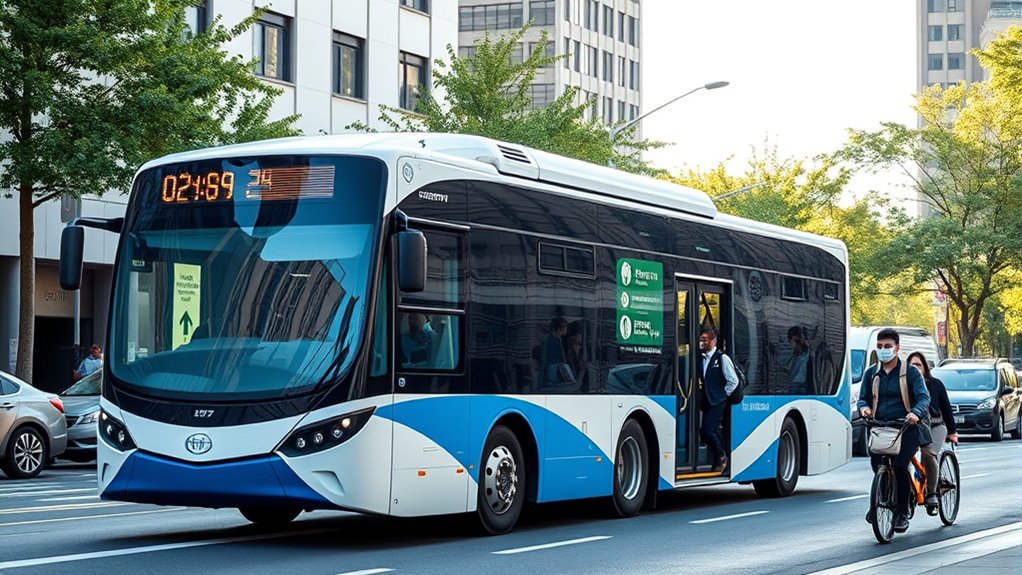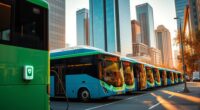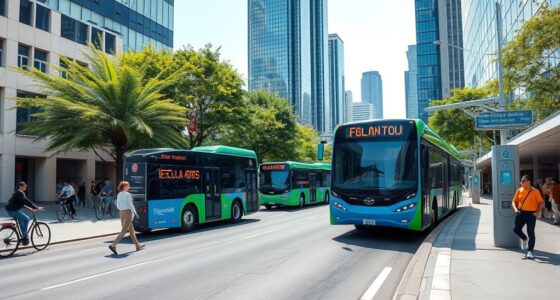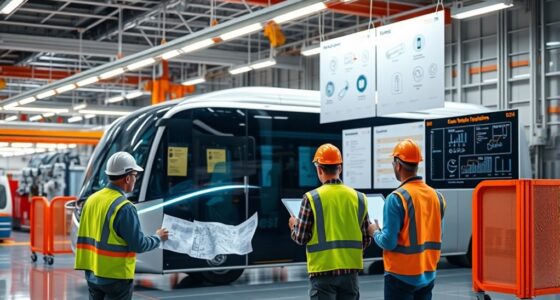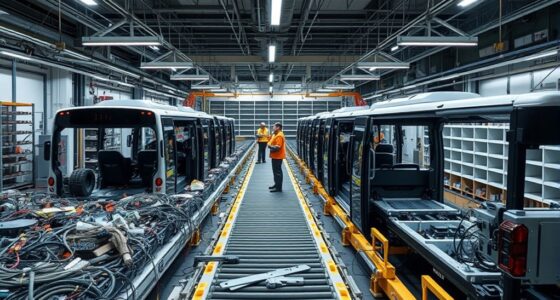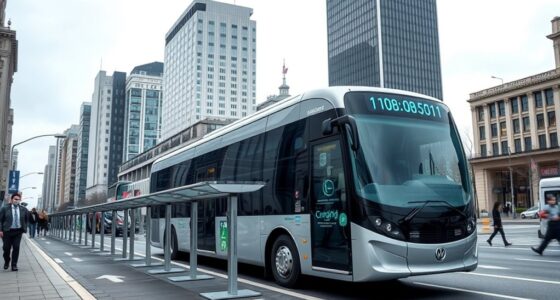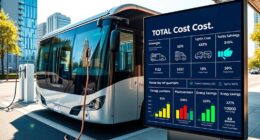COVID-19 hit electric bus adoption hard by straining transit budgets, causing ridership drops and delaying investments. Supply chain issues, especially shortages of semiconductors and imported parts, slowed manufacturing. Despite these setbacks, increasing government policies, infrastructure development, and public awareness are pushing the shift to electric buses. If you want to understand how these factors are shaping the future of electric transit, there’s more to discover below.
Key Takeaways
- COVID-19 caused financial strain on transit agencies, reducing budgets and delaying electric bus procurement and infrastructure investments.
- Supply chain disruptions, including component shortages, hindered electric bus production and deployment efforts.
- Ridership declines decreased fare revenue, making funding for electric buses more challenging amidst economic uncertainties.
- Increased public awareness of air quality and health benefits accelerated demand for electric buses post-pandemic.
- Policy shifts and government incentives aimed at sustainability supported continued electric bus adoption despite pandemic-related challenges.
Pandemic-Induced Financial Challenges for Transit Agencies
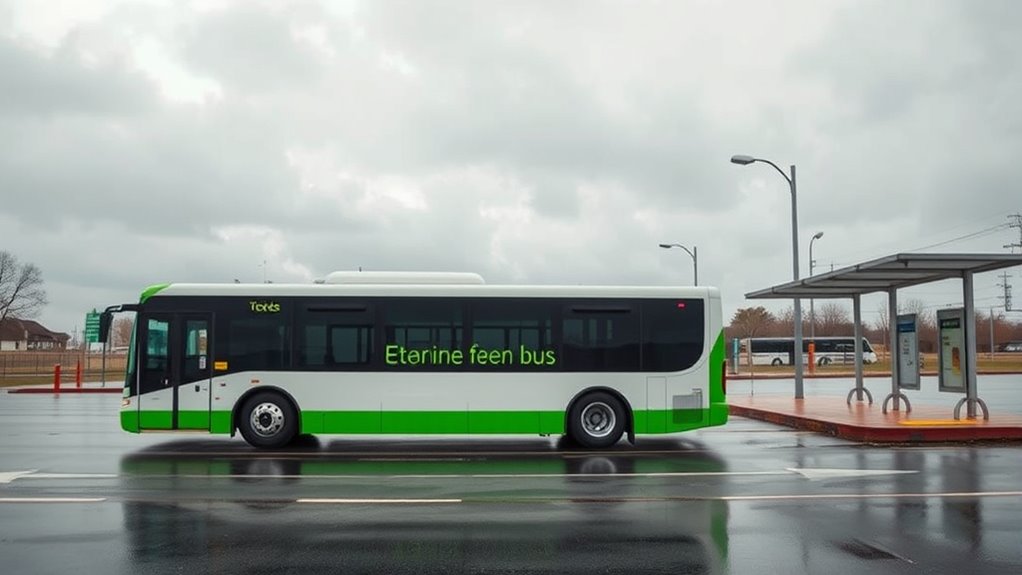
The COVID-19 pandemic has severely strained transit agencies’ finances, forcing them to cut services and seek new funding sources. Ridership plummeted by 81% between April 2019 and April 2020, leading 97% of agencies to reduce service.
By September 2023, vehicle revenue miles reached only 91% of pre-pandemic levels, while ridership recovered to just 74%. Fare revenue losses persist, leaving agencies dependent on unstable public funding. This financial strain emphasizes the importance of funding strategies to ensure sustainable transit systems. Implementing supportive financial measures can help address these ongoing challenges. Additionally, many agencies are exploring innovative funding options to diversify their revenue streams and reduce reliance on traditional sources.
Federal relief, like the $25 billion CARES Act, fell short by nearly $24 billion, creating a $48.8 billion shortfall overall. Declining state and local tax revenues worsen funding gaps, risking service cuts and delaying investments in electric buses.
These financial pressures hinder agencies’ ability to modernize and maintain essential transit services, especially for vulnerable communities relying on affordable transit options. Additionally, the lack of dedicated funding sources hampers long-term planning and infrastructure upgrades necessary for sustainable transit development.
Disruptions in Electric Vehicle Manufacturing and Supply Chains
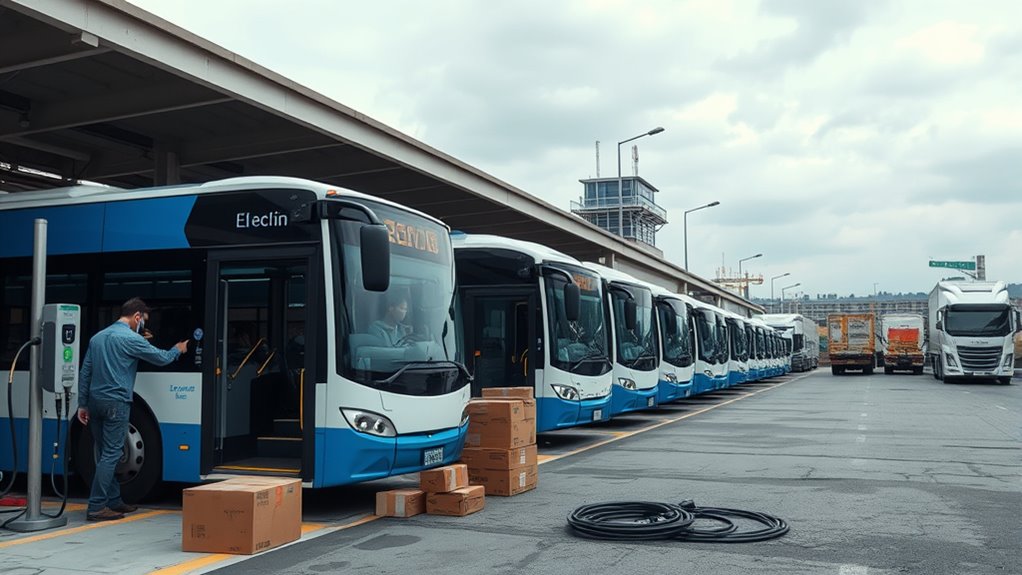
As COVID-19 disrupted transit agency finances and slowed the adoption of electric buses, the broader electric vehicle manufacturing sector also faced significant supply chain challenges. Lockdowns caused widespread manufacturing halts worldwide, delaying production schedules and output.
COVID-19 caused global manufacturing halts, delaying electric vehicle production and supply chains.
Travel restrictions and border closures disrupted raw material and component deliveries, complicating manufacturing efforts. While lithium-ion battery overcapacity provided some resilience, shortages of critical components like semiconductor chips persisted, impacting vehicle production. The reliance on imported parts highlighted the vulnerability of global supply chains and the importance of developing domestic manufacturing capabilities.
Dependence on imported parts intensified supply issues, prompting efforts to develop domestic substitutes and improve inventory management. Global economic pressures further strained suppliers’ capacity to maintain production levels. Additionally, the Jeep Tuning industry experienced similar supply chain disruptions, leading to delays in aftermarket parts availability and installation schedules. Despite these hurdles, heavy-duty electric vehicle manufacturers managed to adapt through strategic supply chain management.
Furthermore, the adoption of smart supply chain technologies can help mitigate such disruptions in the future. The integration of advanced logistics systems can enhance supply chain visibility and responsiveness, reducing vulnerability to future disruptions. Overall, these disruptions slowed electric vehicle manufacturing growth during the pandemic’s peak.
Environmental and Public Health Priorities Post-Pandemic
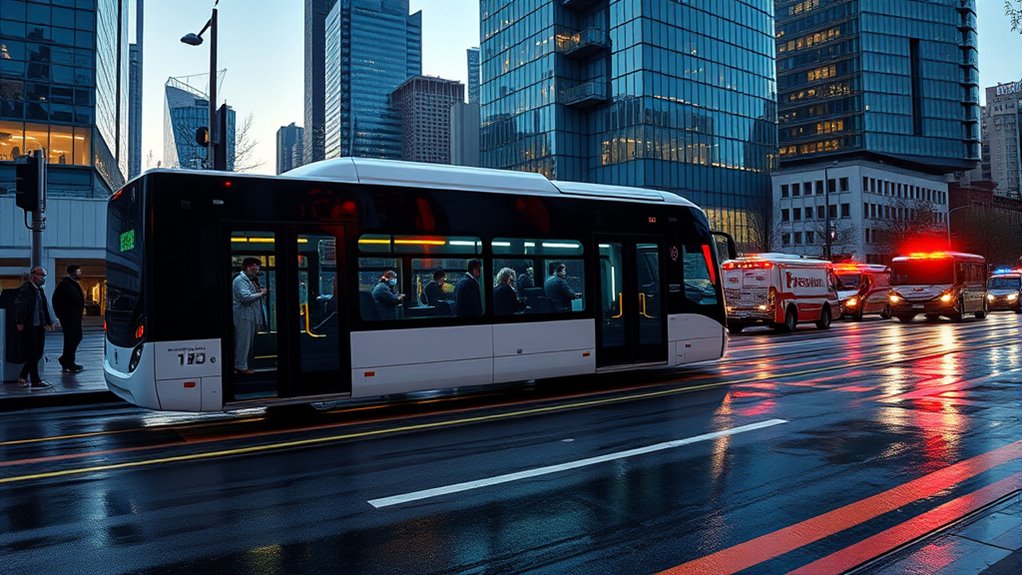
Post-pandemic, environmental and public health priorities have taken center stage in shaping transportation policies. You recognize that electric buses can drastically cut air pollution, lowering asthma attacks and heart disease.
Replacing diesel buses with electric options could eliminate over 2 million tons of greenhouse gases annually in the US. Since electric buses produce zero tailpipe emissions, urban air quality improves, especially in crowded areas.
You also see that cleaner air reduces respiratory problems and enhances overall community health. Vulnerable populations, like children and the elderly, benefit most. Additionally, the increased public awareness of air quality’s impact on health has fueled demand for cleaner transportation.
The pandemic has increased public awareness of air quality’s impact on health and environmental sustainability, fueling demand for cleaner transportation. Governments are now supporting this shift through subsidies and policies, aligning environmental sustainability with public health goals.
Additionally, advances in electric vehicle technology and charging infrastructure are making electric buses more efficient and reliable, further accelerating their adoption.
Policy and Funding Shifts Accelerating Electrification Goals

Policy and funding shifts have played a critical role in accelerating electric bus adoption despite pandemic-related challenges. Government initiatives continue to support the *changeover*, with policies that promote cleaner transportation and strengthen environmental regulations.
Policy and funding shifts drive electric bus adoption amid pandemic challenges.
Enhancements in charging infrastructure make it easier to deploy electric buses efficiently. Budget allocations, though impacted, remain largely committed thanks to prior pledges, while state mandates like California’s zero-emission goals push adoption forward. Solar panels and renewable energy sources are increasingly integrated into public transit systems to further reduce emissions. A focus on conflict resolution skills within policymaking teams helps navigate stakeholder disagreements and maintain progress on electrification projects. Additionally, the development of integrated planning strategies ensures coordinated efforts across agencies and stakeholders. Leveraging zodiac compatibility insights can also aid in understanding regional stakeholder dynamics and fostering collaboration.
Funding strategies such as investment schemes, public-private partnerships, and government grants help bridge financial gaps caused by the pandemic. Innovative financing methods, including green bonds, further support projects.
These combined efforts create a robust regulatory environment that fosters innovation and investment, ensuring that the *shift* toward electric buses stays on track despite economic uncertainties.
Changes in Market Dynamics and Consumer Preferences
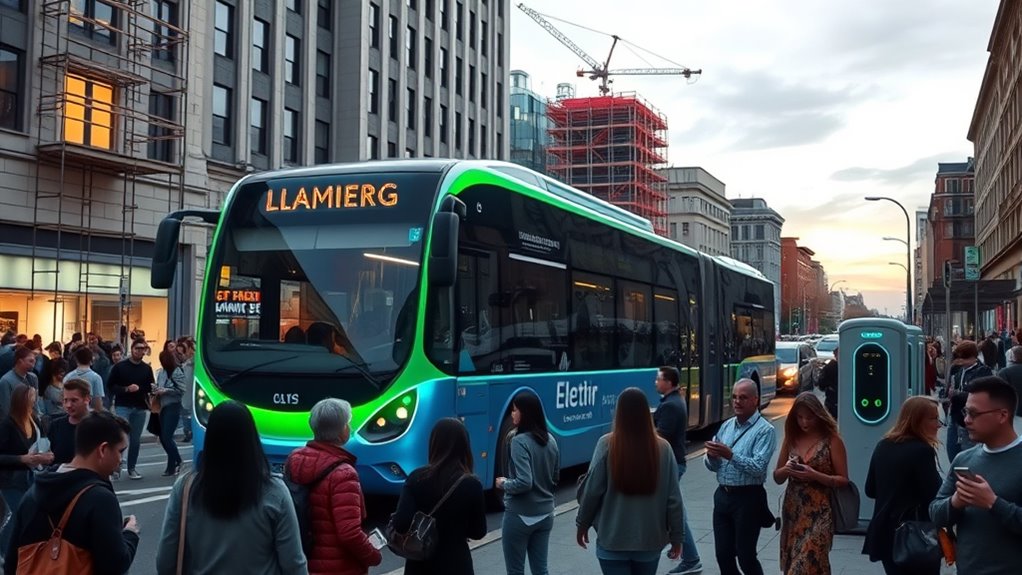
The recovery from COVID-19 has shifted market demand toward cleaner transportation options like electric buses, driven by a growing emphasis on environmental sustainability and public health. You’ll notice that despite reduced ridership, the long-term savings and environmental benefits make electric buses more attractive. Additionally, the focus on space maximization and organization in transit planning is crucial to accommodate this shift efficiently. Consumers now prioritize air quality, health, and sustainability, valuing quieter, smoother rides that improve passenger experience. Although higher upfront costs remain a barrier, lower operating expenses and government support help offset these challenges. Advances in battery technology and infrastructure development further boost viability. As awareness of pollution’s health impacts grows, public demand for eco-friendly transit rises. This shift pushes transit agencies and communities to reconsider their transportation strategies, emphasizing electric buses as essential to post-pandemic recovery and sustainable mobility goals. The importance of infrastructure development continues to play a critical role in supporting widespread electric bus adoption. Moreover, innovations in battery technology contribute significantly to increasing range and reducing recharge times, making electric buses more practical for daily operations. Furthermore, the integration of aesthetic elements such as modern charging stations and visual signage can enhance the overall transit environment, encouraging more riders to choose electric options.
Addressing Equity and Accessibility in E-Bus Deployment
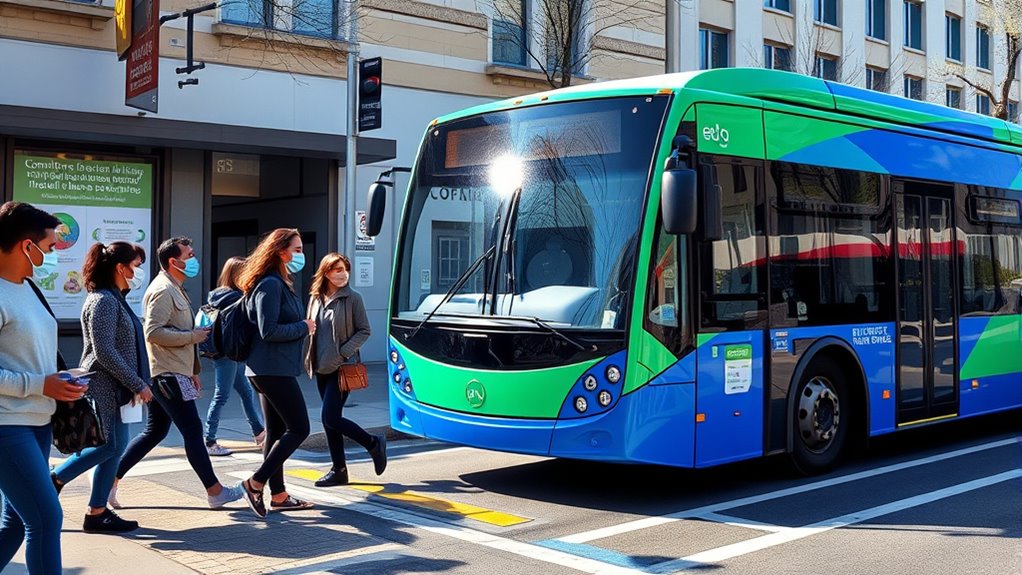
Addressing equity and accessibility in electric bus deployment is essential to guarantee that all communities benefit from cleaner transportation. Communities with lower socioeconomic status often face higher pollution levels, so deploying e-buses can help reduce health disparities.
Ensuring equitable access to electric buses helps reduce health disparities in underserved communities.
However, geographic disparities risk worsening existing transportation inequalities if electric buses aren’t evenly distributed across urban and rural areas. To succeed, you must engage local communities actively, addressing their concerns and ensuring fair access.
Policy support is crucial; governments can implement measures to share benefits equitably. Improving infrastructure, reducing costs, and providing digital tools will enhance accessibility and reliability.
Overcoming budget constraints and supply chain disruptions remains challenging, but targeted efforts can ensure that electric bus deployment promotes inclusive growth and healthier communities for everyone. Additionally, understanding the horsepower of electric dirt bikes can inform better transportation planning and energy use considerations in the development of electric public transit options.
Implementing comprehensive equity strategies is vital for bridging gaps and making sure that advancements in electric transportation reach underserved populations.
Long-Term Outlook for Electric Bus Adoption After COVID-19
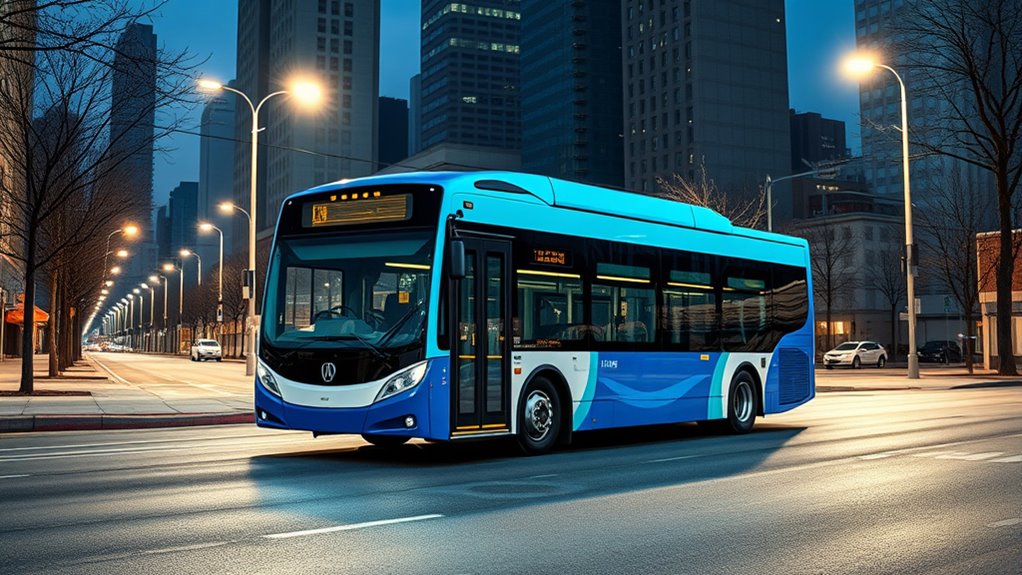
Long-term prospects for electric bus adoption look promising, especially as global markets experience sustained growth driven by environmental concerns and technological progress. By 2032, the market is projected to hit USD 187.8 billion, growing at a CAGR of 14.2%, and could reach USD 920 billion by 2031 with a CAGR of 42.8%. Governments worldwide are setting ambitious targets for zero-emission fleets, supported by incentives like subsidies and regulations. Technological advancements in batteries and charging infrastructure make electric buses more efficient, with longer ranges and faster charging. These improvements reduce operating costs and boost appeal. Additionally, the increasing availability of short-form video content on platforms like TikTok helps raise awareness about sustainable transportation options and influences public opinion. Post-pandemic recovery efforts, especially in Europe and Asia-Pacific, continue to accelerate adoption.
Frequently Asked Questions
How Has the Pandemic Affected the Timeline for E-Bus Infrastructure Deployment?
You might notice that the pandemic caused delays in e-bus infrastructure deployment due to supply chain disruptions and funding reallocations. However, many governments increased investments afterward, accelerating infrastructure development.
You can see cities like Jakarta rapidly expanding their e-bus fleets, showing that post-pandemic recovery efforts and new policies have helped catch up on earlier delays, ultimately speeding up the overall deployment timeline.
What Strategies Are Transit Agencies Using to Overcome Supply Chain Disruptions?
Ever wonder how transit agencies keep moving despite supply chain hiccups? They diversify suppliers, sourcing critical parts like batteries and semiconductors from multiple vendors to reduce risks. They also reshore or nearshore suppliers, use AI for demand forecasting, and implement real-time tracking.
Automating warehouses with robotics and establishing crisis SOPs further bolster resilience. These proactive steps guarantee that even amid disruptions, transit agencies can continue serving their communities efficiently.
How Has COVID-19 Influenced Public Perception of Electric Versus Traditional Buses?
You notice that COVID-19 has made people more concerned about safety on buses. You see that electric buses with antiviral measures seem safer and more reliable, which improves public perception.
You also recognize that electric buses align with environmental concerns, reducing pollution and supporting health. However, economic challenges and supply issues may influence how quickly people accept electric options.
What Role Do Local Policies Play in Accelerating or Delaying E-Bus Adoption?
Local policies profoundly influence electric bus adoption. When you support policies like subsidies, tax credits, and dedicated funding, you help accelerate the shift by making electric buses more affordable and accessible.
Conversely, if policies lack incentives or infrastructure investment, adoption slows down. Your city’s commitment to updating infrastructure and partnering with manufacturers can make a real difference in how quickly electric buses become a standard part of transit systems.
How Are Underserved Communities Being Prioritized in Post-Pandemic Electrification Efforts?
You should focus on how post-pandemic efforts prioritize underserved communities by ensuring equitable access to electric buses and infrastructure.
Engage local residents in planning to meet their specific needs and target areas with poor air quality.
Support policies that allocate funding and incentives to these communities, and collaborate with various stakeholders.
This approach helps reduce transportation disparities, improve public health, and promote environmental justice in areas that need it most.
Conclusion
You might think the pandemic slowed electric bus adoption, but in reality, it accelerated long-term electrification efforts as governments prioritize sustainability and health. Despite supply chain hiccups, investments in clean transit are increasing, proving that COVID-19 didn’t halt progress—it reshaped priorities. As market dynamics shift and equity becomes central, electric buses are poised to become the new standard, making it clear that a greener, healthier future isn’t just possible—it’s inevitable.
